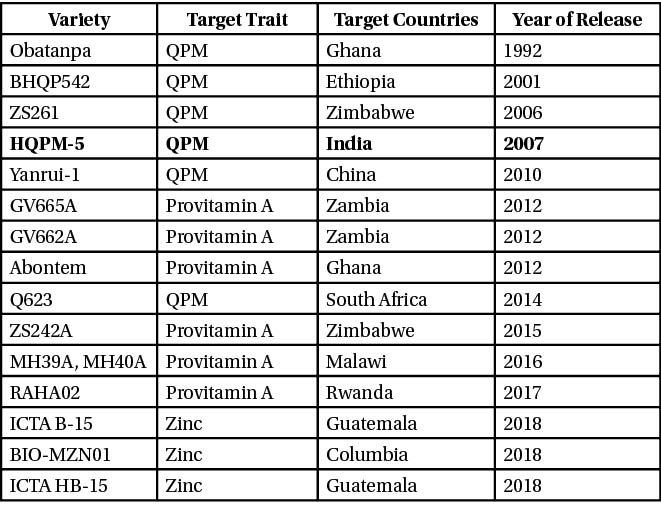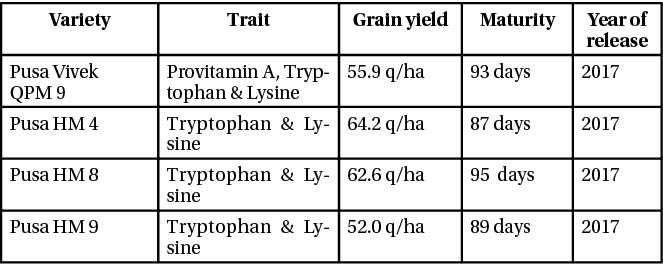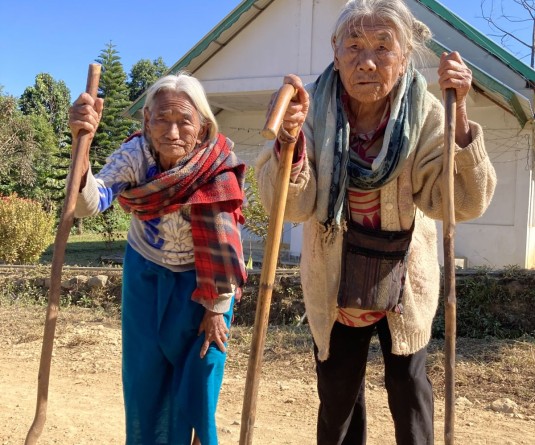
Dr Hannah Krujia Asangla
ACTO – Agronomy, KVK Phek
Biofortification is a process of escalating the density of vitamins and minerals in a crop through plant breeding, transgenic techniques, or agronomic practices. Biofortified staple crops, when consumed regularly, will generate measureable improvement in human health and nutrition. International Food Policy Research Institute explains bio fortification as a scientific method for improving the nutritional value of foods already consumed by those suffering from hidden hunger. Biofortified crops are also a feasible means of reaching rural populations who may have limited access to diverse diets or other micronutrient interventions. Target micronutrient levels for biofortified crops are set to meet the specific dietary needs of women and children, based on existing consumption patterns. Maize (Zea mays L.) is the most important cereal crop worldwide with the highest global production of 1060 million tonnes (FAOSTAT 2017). It is used as food in humans, feed for poultry and livestock, and raw material for a range of industrial and processed products. The first commercial biofortified crop was quality protein maize (QPM), a set of maize varieties developed through conventional plant breeding to have grain with improved protein quality. This was achieved through higher grain levels of the essential amino acids lysine and tryptophan, obtained after crossbreeding with high-lysine maize, which had a natural genetic mutation that altered the amino acid profile of its grain.
A number of biofortification programmes are running all over the globe to counter malnutrition and hidden hunger some in consortia mode and most of them in a project mode. Biofortification was thought to be one of the strategy to give nutritional security to the poor who cannot afford balance diet.
List of some of the provitamin A, Zn and QPM biofortified maize varieties released in different countries across the world

Global malnutrition and hidden hunger
Infant mortality and post partum morbidity is an important parameter for Human Development Index. Globally, there are many countries where the HDI is low due to hidden hunger and protein energy malnutrition. Biofortification of staple food crops is a new public health approach to control vitamin A, iron, and zinc deficiencies in poor countries. About 2 million children are globally affected by iron and zinc deficiency. Close to 20 million pregnant women in developing countries is also vitamin-A deficient. About one fifth of the world’s population is at high risk of zinc deficiency. Zinc deficiency can cause stunting and worsen diarrhea and pneumonia. Iron deficiency is the most common micronutrient deficiency in the world. Anemia (affects more than 1.6 billion people. Iron deficiencies harm mental development and learning capacity in children and reduces adults capacity for physical labor and when severe, increases the risk of mothers in childbirth.
Biofortification in maize
It was long known that maize was a poor source of the critical amino acid lysine. The source of this problem is that the primary storage proteins in the maize endosperm are the lysine poor zeins. Poor agronomic traits and kernel characteristics of the originally identified high lysine mutant were overcome over several decades of intensive breeding efforts to produce advanced lines known as Quality Protein Maize (QPM). QPM represents one of the notable successes, of a nutritionally enhanced staple food crop that has found wide production. QPM is recognized as superior food relative to other maize varieties that can benefit some individuals, specifically young children, at risk of severe malnutrition. The greater direct impact of increased availability of lysine and tryptophan in maize is on animal nutrition and productivity.
The development of high-yielding QPM lines came from the organization, CIMMYT (International Maize and Wheat Improvement Center). Indirectly, it therefore has potential positive benefits for human nutrition at the population level. However, biofortified crop varieties will require considerable investment in seed distribution, labeling, packaging and consumer education to ensure that they are used appropriately as foods in existing diets and food cultures. A series of hybrids were released after Shaktiman-1 like Shaktiman-2, HQPM-1, Shaktiman-3, Shaktiman-4, HQPM-5 and HQPM-7 etc. Among the released hybrids HQPM-1 is popular across India. Huge quantity of seeds is been produced by NSC and Dept. of Agriculture and Cooperation receives huge indent for these hybrids from various State Seed Corporations. The QPM hybrids, HQPM-1, HQPM-5, and HQPM-7 are high yielding, tolerant to abiotic stress and are resistant to many diseases. Vivek QPM-9 which was developed through marker assisted selection is recommended for high altitude regions of Himalayan range and North East Region. This is the major reason for the impact it has made in over years.
Biofortified maize varieties developed by ICAR-Indian Agricultural Research Institute, New Delhi are as follows:

Biofortified crops with high iron, zinc, folate, protein, vitamin A and other nutrients play a crucial role in the nutritional security for the resource poor families. Hence, consumption of biofortified staple crops will help in the development of malnutrition thereby improve the human health condition. Cumulatively, more than 100 biofortified varieties across ten crops have been released in 30 countries, where second and third waves of even higher nutrient lines are being tested for future release. The goal is to reach one billion people with biofortified foods by 2030.
References:
• Breeding and disseminating quality protein maize (QPM) for Africa. (2007)
• Maize production systems for improving resource-use efficiency and livelihood security (2013)
• Food and Agriculture Organization of the United Nations, Rome, Italy (2017)
• Biofortified Varieties:Sustainable Way to Alleviate Malnutrition (2017)
• Nutritional quality improvement in maize: Progress and Challenges (2019)




